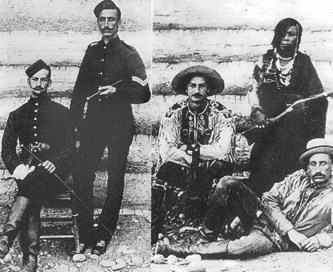Major Walsh (left in both photos) was first assigned to Fort McLeod in what is now Alberta, until he was assigned the task of erecting Fort Walsh in 1875 in the Cypress Hills in what is now Saskatchewan. Walsh is pictured here dressed as a rough plainsman, wilderness wanderer and looking very much the part of a fun-loving, easy going no-fuss individual. Other photos of the North West Mounted Police attest to the fact that the Major and some of his colleagues preferred comfortable wear, such as a large-brimmed hat for riding in the hot summer sun and more comfortable trousers than the police issue. These informal clothes had likely been bought on a shopping trip to Fort Benton, Montana. But, there was a very serious side to this policemen. While in charge at Fort Walsh, he became known for his influence and friendship with Sitting Bull, chief of the approximately 5,000 Sioux who sought refuge in Canada in 1876-77. He was a skilled negotiator--speaking through Métis interpreters. It was difficult work, and he did have confrontations with Sitting Bull that could have turned serious had there not been a basic respect between the two. When buffalo were getting scarce, in late 1870s, the government was faced with bands of starving people. There were about 3000 Sioux who crossed the border and camped near Wood Mountain in December of 1876. Walsh pretty well moved his quarters there, patrolling with the message to obey Canadian laws. The men were given a ration of ammunition to hunt for their food. In 1877, more Teton Sioux were crossing the border. In May, more Sioux crossed over at Pinto Horse Butte, near Wood Mountain with Chief Sitting Bull. In August of 1877 buffalo were getting very scarce forcing the government in Ottawa to send flour, beef and bacon to the police posts. Canadian tribes — Crees, Blackfoot, Bloods were also begging for food. By 1880, the Dominion government thought Major Walsh was not stern enough with Chief Sitting Bull to get him and his followers to return to the USA. Consequently, in July 1880 Walsh was transferred to Fort Qu’Appelle. Walsh also obtained leave to travel east (traveling via Winnipeg, St. Paul Minnesota and Chicago) to see family in Ontario. He also called on the Prime Minister wanting dialogue between Canadian and American authorities for leniency in dealing with Sitting Bull, even to offer him a reservation for his people in Canada. Records show that Macdonald made no move in that direction. The new commander at Fort Walsh was Crozier who followed the Prime Minister’s orders that Canada should not be handing out rations to American tribes when the American authorities were willing for the Sioux to return to their territories. Finally, on July 19, 1881, Inspector Alex Macdonald and Jean-Louis Légaré, long time trader of Wood Mountain accompanied Sitting Bull to Fort Buford, Dakota Territory, where he and his people surrendered and were assigned to reservations.
Sources: Various books & photos from The Canadians, Time-Life Books.
Contact Terri Lefebvre Prince,
Heritage Researcher,
City of Yorkton Archives,
Box 400, 37 Third Avenue North
Yorkton, Sask. S3N 2W3
306-786-1722
heritage@yorkton.ca



